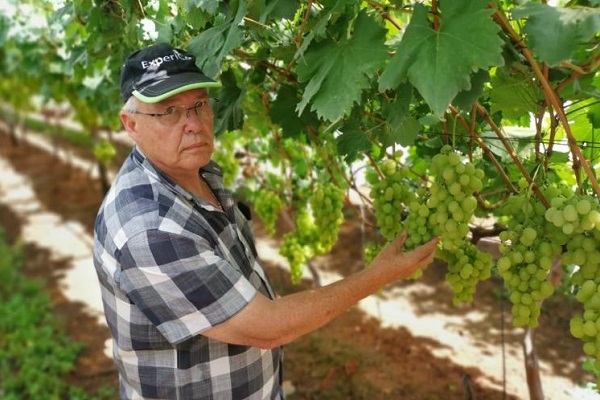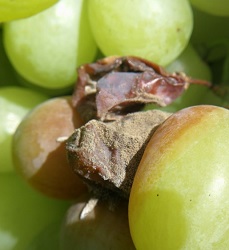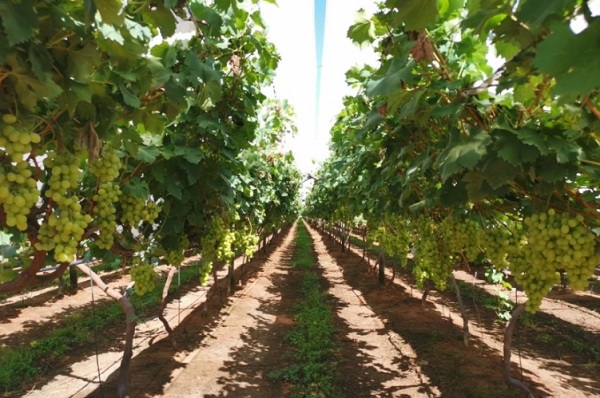A system to manage the ever-present risk of postharvest decay on table grapes is in its second year of advancement towards a user model for the grower or packhouse manager in the Groblersdal/Marble Hall area, where the Limpopo grape harvest is underway.
Dr Johan Fourie, research fellow at ExperiCo Agri-Research Solutions in Stellenbosch, who developed this system, is applying the risk model on behalf of Laeveld Agrochem, delivering services in crop protection and plant nutrition in the greater industry in Limpopo. In collaboration with Anton Bredell of Laeveld Agrochem in Marble Hall, a programme was launched to raise awareness of the different types of pathogens responsible for grape decay in the area and to identify other pre- and postharvest factors influencing table grape quality.
 Dr Johan Fourie inspecting a vineyard to assess its risk profile for postharvest decay (photos supplied by ExperiCo)
Dr Johan Fourie inspecting a vineyard to assess its risk profile for postharvest decay (photos supplied by ExperiCo)
“The same advice is not applicable to everyone - an accurate identification of the causal pathogen is needed to ascertain which of the pathogens occur and what needs to be addressed,” says Dr Fourie, the previous managing director of ExperiCo.
“A number of plant pathogens may cause pre-harvest rot on table grapes, but they are not of equal importance. The grey mould pathogen, Botrytis cinerea, is the main pathogen of concern, causing major losses close to harvest and during post-harvest handling. There are sometimes erroneous reports coming from the markets regarding the kind of decay found in a consignment."
 Decay caused by Botrytis and Rhizopus fungi
Decay caused by Botrytis and Rhizopus fungi
Already starting around five weeks prior to harvest, Dr Fourie and his team of Mimi Otto, Dr Pieter Louw and Anné Matthee monitor various pre-harvest factors on around 30 sites in the area, with a focus on disease incidence and severity.
Maintaining postharvest quality
This data is then used, along with other factors, to manage risk in the handling of table grapes, since, as he says, “table grape quality cannot be improved after it has been harvested, only maintained”.
 Likewise, facility and handling practices are noted in the packhouse prior to the grapes being dispatched for export.
Likewise, facility and handling practices are noted in the packhouse prior to the grapes being dispatched for export.
Right: Botrytis decay
"The information triggers a knowledge-based action plan: equipping the producer or packhouse manager to make informed decisions based on the risk profiles from the vineyard and pack-house assessments," he explains.
Informed decisions on the levels of decay and quality risks allow producers to confer with their exporters with more confidence, he adds.
He points out that the careful risk management of post-harvest decay and other quality attributes is of relevance to all of South Africa’s grape-producing regions, not only Limpopo where the programme has been initiated.
 Good canopy management, as illustrated here, reduces the risk of postharvest decay
Good canopy management, as illustrated here, reduces the risk of postharvest decay
For more information
 Dr Johan Fourie
Dr Johan Fourie
ExperiCo
Tel: +27 21 887 1134
Email: johan@experico.co.za
Dr Pieter Louw
Tel: +27 21 887 1134
Email: Pieter@experico.co.za
www.experico.co.za
December 07, 2020 at 09:13PM
https://ift.tt/3qAsHF7
Grape producers & packers in stronger position to manage postharvest decay risk - FreshPlaza.com
https://ift.tt/3eO3jWb
Grape

No comments:
Post a Comment